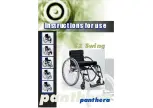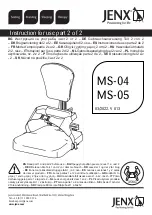
Instructions for use S2 Swing
Instructions for use S2 Swing
4) Angle of the backrest
The angle of the backrest can be adjusted by fi rst twisting the backrest lock ec-
centric out of the way so that the lock does not get in your way, and then adjusting
the screws to adjust the angle.
Do as follows, see fi gure 5:
Dismantle the back locking function by pulling the wire (1) and folding the
backrest forward.
Loosen the lock screws (2) and unscrew them a few rotations using socket head
key no. 5.
Twist the backrest lock eccentrics (3) downwards so that the lock faucet does
not fi x the backrest in place. Use cap key no. 19. Do this on both sides.
Then adjust the angle of the backrest by fi rst
loosening the lock nuts (4) using cap key no. 13,
and then screw the adjustment screws in or out
(5) using the 5 mm socket head key. If you
unscrew the adjustment screws the backrest will
tilt forward. If you tighten the adjustment screws
the backrest will tilt backwards. It is important
to adjust both sides equally to avoid the backrest
tubing becoming crooked. Test this by putting
the backrest in upright position and checking
that both adjustment screws are touching the
frame. Try out suitable backrest angles and
tighten the lock nuts once you are satisfi ed.
To reengage the back locking function pull the
backrest into upright position and twist the
backrest lock eccentrics so that the lock faucets spring out into their tracks.
Then tighten the lock screws. Do this on both sides.
1.
2.
3.
4.
5.
5
6
1
4
2
5
3
Figure 5.
Back locking
function.
3) Tension of the heel strap
The tension of the heel strap can be adjusted and will affect how far forward you
place your feet on the footrest. The appropriate tension depends largely on how
long or short your legs are.
5) Tension of the backrest upholstery
The back upholstery can be tightened or loosened by adjusting the Velcro band at
the back. The back upholstery also has a fl ap fastened with Velcro under the seat
upholstery. This can be moved back or forwards to obtain the required tension in
the lower section of the back upholstery (known as the seat bucket). By adjusting
these things you can form the lower part of the back upholstery to suit the shape
of your back and obtain good support for your lower back. Start by loosening the
band and sit as far back in the chair as you can. Then tighten the band to give you
good support. If it feels as though you are not sitting far back enough in the chair it
may be because the back upholstery fl ap is fastened too far forward under the seat.
Relax this fl ap and move it back.



























